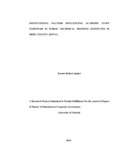| dc.description.abstract | Academic staff turnover has not only become a major problem in Kenya but also
across many other countries in the world. It comes with high cost and other
adverse effects in the provision of quality services in the institutions of higher
learning globally. Turnover of employee in any organization can have either
positive or negative impact since it comes with its cost. The Government of
Kenya is currently pursuing a new development blueprint (vision 2030) covering
the period 2008 to 2030. This blue print identifies Technical and Vocational
Education Training (TVET) as a major pillar in its achievement. This is because
TVET institutes plays the role of furnishing skills required to improve
productivity, raise income levels and improve access to employment opportunities
in various sectors. The study aimed at investigating the institutional factors
influencing academic staff turnover in public technical training institutes in Meru
County, Kenya. The study objectives aimed at determining the extent to which
working environment, manager’s supervisory support, communication system and
compensation influence academic staff turnover in public technical training
institutes in Meru County. Theoretical background for the study was provided by
the Herzberg’s (1959) two factor theory also known as Herzberg’s motivational
hygiene theory and dual factor theory. The research adopted descriptive survey
design. The study comprised a sample size of 124 academic staff members
derived from a target population of 180 members. Also included were 27 heads of
departments. Two different sets of questionnaires were used as the main research
instruments one for the academic staff and the other for the heads of departments.
The collected data was analyzed using both quantitative methods. It was the
presented in tables, pie-charts and graphs. Qualitative data was analyzed through
narrative summary analysis technique. The findings of the study revealed that the
academic staff turnover in the investigated institute was high and the respondents
concurred that it was influenced to a very and great extent by; working
environment (non-conducive) agreed by a mean of 71.1% academic staff and
80.6% heads of departments, inappropriate attributes of manager’s supervisory
support with a mean agreement of 70.6% heads of departments and 76.1%
academic staff, communication system with a mean of 4(great extent) and average
standard deviation of 0.57, and compensation as agreed by a mean average of 4
(great extent) with average deviation of 0.475. The study concluded that academic
staff turnover was influenced by factors such as low compensation, poor working
environment, poor communication systems and inappropriate manager’s
supervisory support. The study recommended that the Boards of Management
should liaise with the relevant government ministries in order to address these
turnover triggers to ensure retention of the teaching staff in public technical
training institutes. The study suggested the following areas for further study;
similar studies may be done in other counties across the country to establish other
institutional factors influencing academic staff turnover, a study on factors
influencing the performance of board of managements in Technical Training
Institutes, institutional challenges facing the academic staff, institutional factors
influencing the academic staff and the institutional factors influencing the
turnover of the non-teaching staff in Technical Training Institutes. | en_US |

